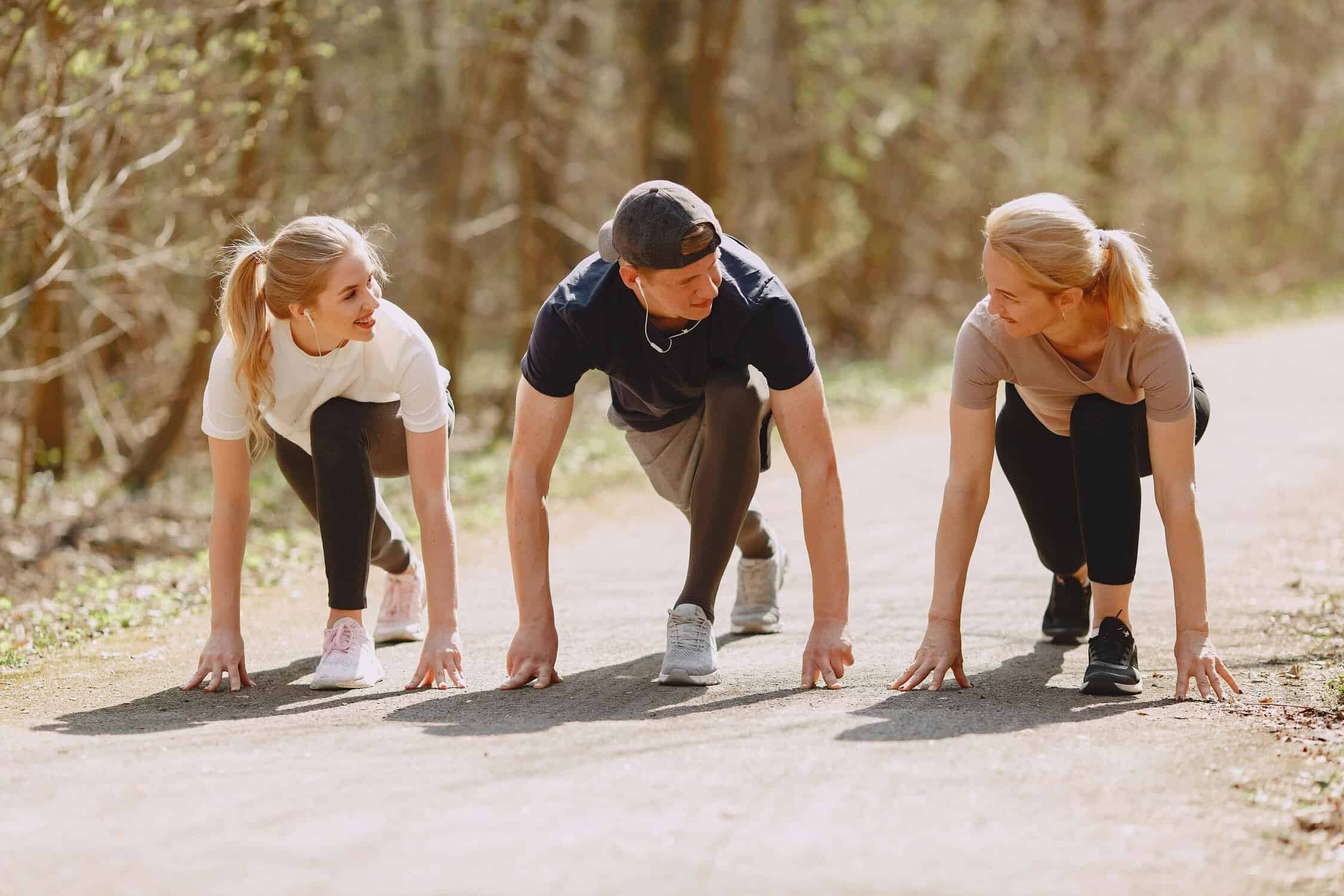We’re all looking to improve our race times, minimize the risk of injury, and feel stronger in our bodies — but many don’t realize the power behind leveling up your runs actually lies off the pavement. Strength training, for runners, builds all the supporting (and active) musculature you use when logging miles; building strength is what keeps you running faster, harder, and for more years of your life.
In particular, if prepping for a half marathon, strength training for runners is an essential part of your movement diet, alongside nutrition and hydration, and mental training.
Before you head to the weight room to start loading up a barbell, let’s take a look at the benefits of strength training and how to incorporate it into your running routine.

Benefits of Strength Training for Runners
Let’s clarify something: Cross-training, while also beneficial for runners, is different from strength training. For runners, cross-training involves swimming, biking, or other forms of cardio intended to keep your cardiovascular training up but impact down.
Meanwhile, strength training focuses on increasing muscular strength and endurance through resistance exercises, usually dumbbells, barbells, or kettlebells.
A strength training program should be added to your workout regiment in addition to your running training sessions.
Research shows adding a simple strength workouts regimen to your training cycle will improve your running form, enhance your body composition, and help propel you to your new PR. By performing simple lifts, you’ll bulletproof your body against common overuse injuries and help your body run more efficiently.
Plus, strength training is a great way to stay in shape.
A 2019 study listed the following benefits of strength training for distance runners:
- Improved running economy
- Deceased risk of injury
- Better race times and sprint speeds
- Improved endurance
- Stronger muscles, joints, and tendons
- Improved mental health
Related: How Men & Women Respond To Strength Training, According To Science
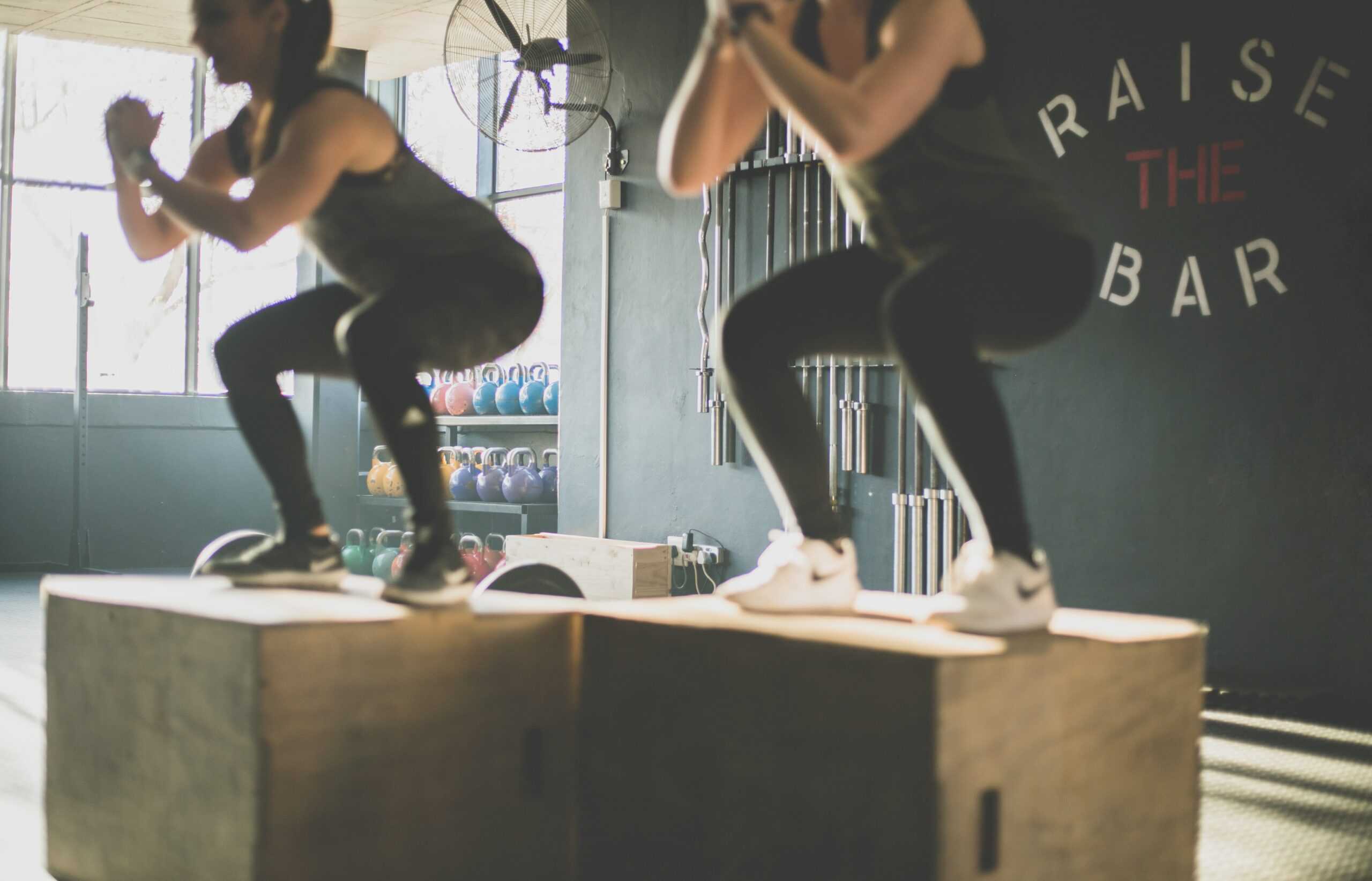
The Best Workouts for Runners
Lower Body Workouts
Lower body workouts are obviously good for runners. To use your legs, it’s a good idea to strengthen your legs.
Working these muscles will not only improve our performance but protect the joints and reinforce connective tissues that take a beating from our long miles.
Instead of merely apologizing to your knees and ankles, give them some stability with these moves. Squats and lunges can be performed as bodyweight exercises, though you can increase the difficulty of any of these great exercises using resistance bands.
You’ll need a set of dumbbells or kettlebells.
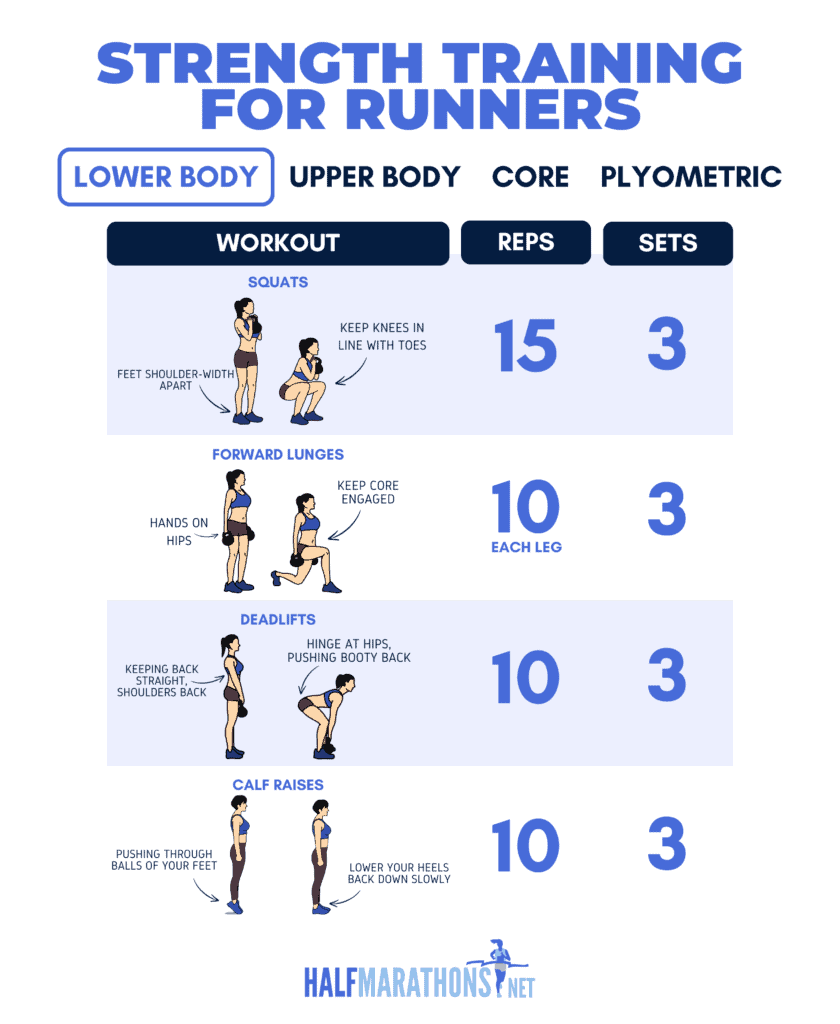
1. Squats
Squats are one of the most effective and efficient resistance exercises runners can perform that don’t require you lift weights.
You’ll see glute gains while increasing flexibility in your hips and strengthening your quads. Feel the burn!
- Start by standing with your feet shoulder-width apart and your toes slightly pointing outward.
- Lower your body by bending your knees and hips while keeping your back straight, chest up, and core engaged. Get low! Or at least as low as your flexibility allows. Ir would be ideal if you could lower until your thighs are parallel to the ground. (if you’re not there yet, it’s okay, it will improve.)
- Push through your heels to return to the standing position. Keep your knees in line with your toes to keep your joints safe.
If you’re looking for a more challenging body strength squat exercise, consider a jumping split squat.
Suggested reps: 3 sets of 15 performed daily
Related: Which Exercise Type Improves Running Economy Most?
2. Forward Lunges
Lunges are functional to runners because they work all the big leg muscles – quads, hamstrings, glutes, as well as your core. There are many different lunge variations, but we will start with the forward lunge.
- Stand with your feet hip-width apart and your hands on your hips.
- Take a step forward with one leg, bending both knees to lower your body until both knees are at 90-degree angles.
- Push through your front heel to return to the starting position, and then repeat the movement with the other leg. Focus on keeping your core engaged to maintain balance.
If you find you can’t perform any variation of a forward lunge, consider a glute bridge.
Suggested reps: 3 sets of 10 on each leg performed daily
3. Deadlifts
Weight training for runners should almost always include deadlifts to help develop the muscles in your posterior chain.
We recommend starting out with traditional deadlifts (using light to medium dumbbells) and then moving on to single-leg deadlifts once you’ve mastered this move.
- Stand with your feet hip-width apart, with a dumbbell in each hand, held in front of your thighs, palms facing your body.
- Keeping your back straight and shoulders back, engage your core muscles.
- While maintaining a slight bend in the knees, hinge at the hips, pushing your booty back.
- Lower the dumbbells until they reach the mid-shin level or as far as your flexibility allows while maintaining a straight back.
- Push through your heels, engage your glutes and hamstrings, and stand up by extending your hips and straightening your knees. Keep the dumbbells close to your body as you rise.
Suggested reps: 3 sets of 10
4. Calf raises
Too many runners end up in the doctor’s office with calf strains and pulls. Don’t let this be you! Calf raises are easy to implement into your running workouts. You’ll want to do two different moves to work both the gastrocnemius muscle and the soleus muscle.
You can do these exercises on the floor or on a raised surface like a step or block for an extended range of motion.
To target the gastrocnemius:
- With your feet hip-width apart and legs straight, slowly raise your heels off the ground by pushing through the balls of your feet, lifting your body as high as you can onto your toes.
- Lower your heels back down below the level of your toes slowly, feeling a stretch in your calves, and then repeat.
To target the soleus, do the same movement but with a bent knee. You should feel it lower down on your calf.
Suggested reps: 3 sets of 10 of each movement
Upper Body Workouts
Just because it doesn’t feel like your upper body is doing the heavy lifting on your runs doesn’t mean your arms should be left to flop around like noodles.
Training your upper body will enhance your posture, strengthen your arm swing which supports momentum and stability, and improve your power.
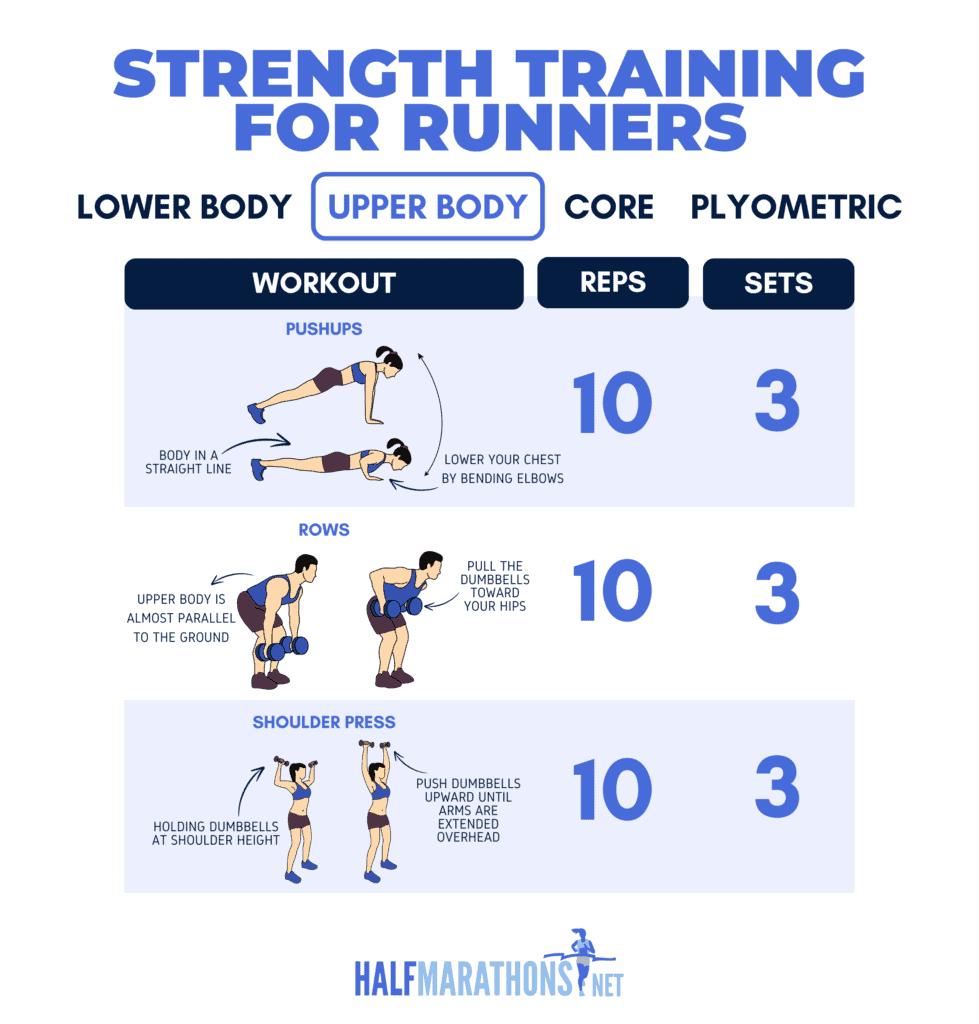
1. Pushups
Pushups are awesome for strengthening your shoulders, chest, arms, and core. If you are more of a “knees pushup” type person, that’s cool. But consider doing a raised pushup (with your hands on a platform) instead to get the core more involved in the movement.
- Start in a plank position with your hands placed slightly wider than shoulder-width apart, palms flat, and your body in a straight line.
- Lower your chest toward by bending your elbows. Aim to go as low as your chest hovers just above the ground without touching it.
- Push up! Extend your arms and return to the starting position.
Suggested reps: 3 sets of 10
2. Rows
This will target your upper back muscles, which tend to cave forward when fatigue sets in on long distance runs.
- Stand with your feet hip-width apart, holding a dumbbell in each hand.
- Bend your knees just a bit and hinge at your hips, leaning forward until your upper body is almost parallel to the ground.
- Pull the dumbbells toward your hips, squeezing your shoulder blades together.
- Lower the dumbbells back to the starting position with control, and repeat the arm movement.
Suggested reps: 3 sets of 10
3. Shoulder press
This simple move will enhance your shoulder strength which will help with running posture and arm swing.
- Stand with your feet shoulder-width apart, holding a dumbbell in each hand at shoulder height.
- Push the dumbbells upward until your arms are extended overhead, then lower them back to shoulder height. .
Suggested reps: 3 sets of 10
Core Workouts
Your balance and stability come from your core muscles, and this is essential to run strong. Core strength will help prevent injury by keeping your body in proper alignment. Finally, a strong core helps maintain your form, even when you get really fatigued. Give these strength training exercises a try to boost your core muscles.
Related: The 9 Most Important Core Exercises for Runners
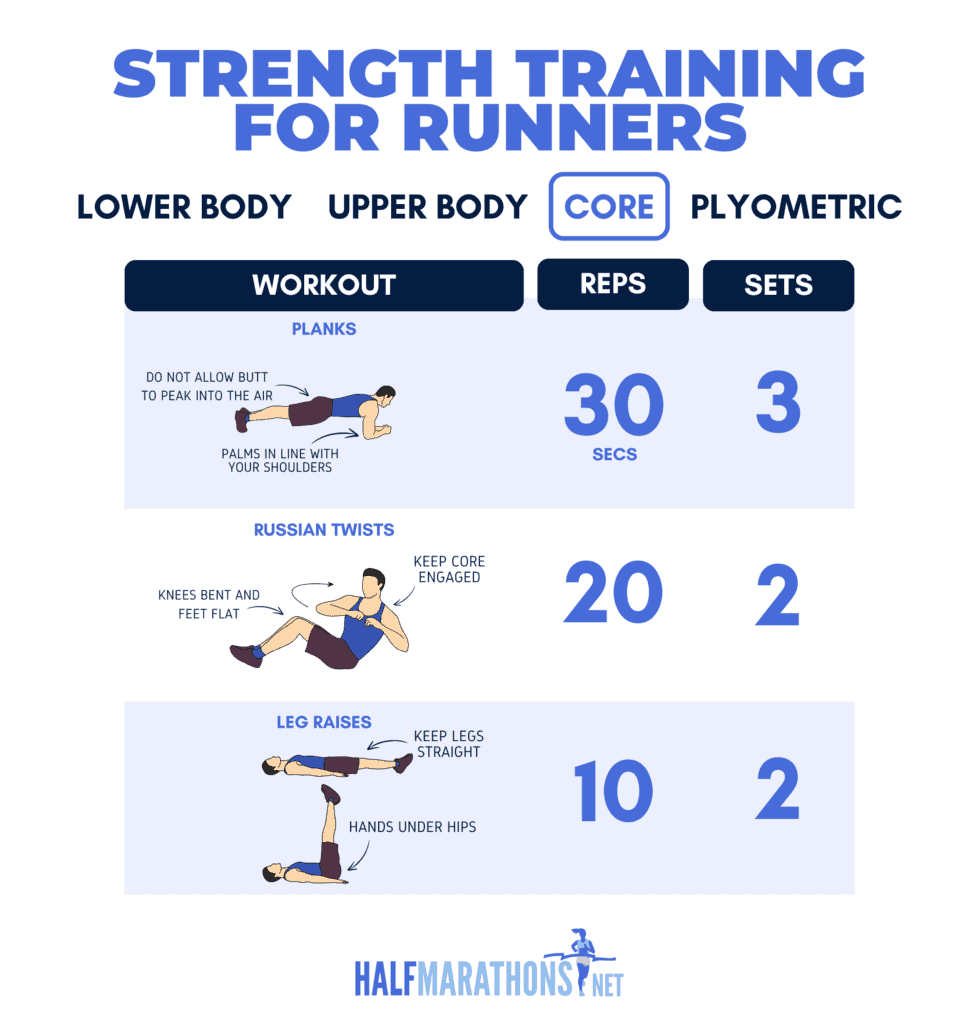
1. Planks
Planks are essential for runners because they strengthen the core muscles, including the abdominals, obliques, and lower back. They also target the shoulders and hips. All of these body parts work together to maintain proper posture when running.
- Start in a pushup position with your palms on the ground and in line with your shoulders. Position your feet, knees, and quadriceps Maintain a neutral spine, meaning do not allow your butt to peak into the air or your hips to sag down toward the ground. Engage your core muscles to keep your body stable. Hold this position for one minute.
Suggested reps: 3 sets of 30 seconds
2. Russian twists
To fire up your obliques, give these a try.
- Sit on the ground with your knees bent and your feet flat.
- Lean back slightly, engage your core, and lift your feet off the ground.
- Then twist your torso to one side, then repeat the movement on the other side.
Suggested reps: 2 sets of 20
3. Leg raises
We love leg raises for runners because the move is awesome for building strength in the lower abdominal muscles and hip flexors. For runners, this adds core stability and is crucial for good upright posture.
- Lie on your back with your hands under your hips, palms facing down.
- Keeping your legs straight, lift them upward until they are perpendicular to the floor, then slowly lower them back down without letting them touch the ground.
- If this puts any strain on your lower back, stop. You can modify by bending your legs at the knees or doing one leg at a time.
Suggested reps: 2 sets of 10
Plyometric Exercises
Plyometric exercises improve your running performance because they improve power.
These high-octane moves will improve speed and add efficiency to your stride. To avoid overtraining the legs, most coaches recommend adding these moves into your base training or off-season cycle because they can be taxing.

1. Box jumps
This lower body move works the whole lower body and will improve your explosivity.
- Start by standing in front of a sturdy box or platform with your feet hip-width apart. (The height will depend on your fitness level. Intermediate athletes can star with a 20” box.)
- Bend your knees, swing your arms for momentum, and jump onto the box, landing with both feet securely on top.
- Step down.
If your knees aren’t feeling the jumping, you can modify this move by doing a step up. Instead of jumping on the platform, step up onto it and then step back down.
Suggested reps: 3 sets of 5
2. Burpees
Burpees are torturous and effective because they work your whole body simultaneously. The move requires strength, agility, and coordination.
- Begin in a standing position, then quickly drop into a squat with your hands on the floor.
- Kick your feet back to a plank position, perform a push-up, then jump your feet back to the squat position.
- Burst upward into a jump, reaching your arms overhead. That’s one! .
Suggested reps: 3 sets of 8
3. Lunge jump
This move will torch the legs and improve your stride efficiency. It will also work on leg strength, power, and coordination.
- Start in a lunge position.
- Jump into the air, switching the positions of your feet mid-air, and land in a lunge with the opposite foot forward.
- Repeat the movement, alternating legs,
Suggested reps: 2 sets of 8 on each side
Tips for Runners Strength Training
1. Focus on functional movements
For runners, strength training doesn’t have to be complex movements or Olympic lifts. And it shouldn’t be HIIT because that could lead to potential overuse or overtraining.
Runners should focus on functional movements, which mimic real-life movements. Functional movements typically engage multiple muscle groups and joints simultaneously. Since these develop strength, stability, and mobility in a way that improves your ability to perform everyday activities, it’ll help you run more efficiently and safely.
2. Work your total body
As a runner, you already work your legs pretty hard. But that doesn’t mean you should skip leg day — or think you don’t need to strengthen your upper body because it’s used less in running. Focusing on various muscle groups ensures that all parts of your body receive equal attention, preventing any muscular imbalances.
3. Prioritize form
Proper form is essential to ensure safety and promote muscle development. As you get going on your strength training journey, consider watching yourself in a mirror or filming yourself to check out how your body is moving. It will help you correct any potentially hazardous movements straight away.
And remember, always master form before adding weight.
4. Progressive overload
Progressive overload simply means that you gradually increase the demands placed on your muscles over time. This promotes muscle growth and strength gains.
Think about it like your running training plan: You build up your mileage from 0 to 13.1 slowly, and start with flat runs before you move to hill repeats or sprint training. With strength training, you should be increasing weight or repetitions but not both. What you increase will depend on where you are in your running training cycle, your running goals and your chosen distance.
For example, you can add plyometric movements and heavier lifts to enhance speed as you base train. But if you’re looking to maintain during your in-season training, then sticking to lighter weight and simple moves will be your best bet. Loading can get complicated if you have advanced goals, and we recommend consulting a personal trainer, running coach, or physical therapist if you want to maximize your potential.
If you are looking for a training app that incorporates strength training, cross-training, and plyometrics – consider Runna. Use code HALF for 2 weeks free.
5. Rest
You need rest! This is the most important tip for runners. When you strength train, you create small tears in your muscle fibers. Rest periods allow these fibers to repair and grow stronger, leading to muscle development.
And just like in running, if you don’t rest you risk overtraining and injury. That’s why we target different muscle groups on different days and take days off in between.
How to Add Strength Training to Your Training Schedule
Here’s when to add the moves into your running training cycle.
| Day | Workout |
| Sunday | Rest |
| Monday | Lower body |
| Tuesday | Rest |
| Wednesday | Upper body |
| Thursday | Rest |
| Friday | Core |
| Saturday | Rest |





